User:Stranger43286/sandbox
This is history of World War II
Background
[edit]Aftermath of World War I
[edit]
World War I had radically altered the political European map with the defeat of the Central Powers—including Austria-Hungary, Germany, Bulgaria, and the Ottoman Empire—and the 1917 Bolshevik seizure of power in Russia, which led to the founding of the Soviet Union. Meanwhile, the victorious Allies of World War I, such as France, Belgium, Italy, Romania, and Greece, gained territory, and new nation-states were created out of the dissolution of the Austro-Hungarian, Ottoman, and Russian Empires.[1]
To prevent a future world war, the League of Nations was established in 1920 by the Paris Peace Conference. The organisation's primary goals were to prevent armed conflict through collective security, military, and naval disarmament, as well as settling international disputes through peaceful negotiations and arbitration.[2]
Despite strong pacifist sentiment after World War I,[3] irredentist and revanchist nationalism had emerged in several European states. These sentiments were especially marked in Germany because of the significant territorial, colonial, and financial losses imposed by the Treaty of Versailles. Under the treaty, Germany lost around 13 percent of its home territory and all its overseas possessions, while German annexation of other states was prohibited, reparations were imposed, and limits were placed on the size and capability of the country's armed forces.[4]
Germany and Italy
[edit]The German Empire was dissolved in the German Revolution of 1918–1919, and a democratic government, later known as the Weimar Republic, was created. The interwar period saw strife between supporters of the new republic and hardline opponents on both the political right and left. Italy, as an Entente ally, had made some post-war territorial gains; however, Italian nationalists were angered that the promises made by the United Kingdom and France to secure Italian entrance into the war were not fulfilled in the peace settlement. From 1922 to 1925, the Fascist movement led by Benito Mussolini seized power in Italy with a nationalist, totalitarian, and class collaborationist agenda that abolished representative democracy, repressed socialist, left-wing, and liberal forces, and pursued an aggressive expansionist foreign policy aimed at making Italy a world power, promising the creation of a "New Roman Empire".[5]
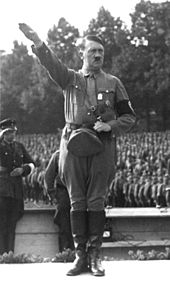
Adolf Hitler, after an unsuccessful attempt to overthrow the German government in 1923, eventually became the Chancellor of Germany in 1933 when Paul von Hindenburg and the Reichstag appointed him. Following Hindenburg's death in 1934, Hitler proclaimed himself Führer of Germany and abolished democracy, espousing a radical, racially motivated revision of the world order, and soon began a massive rearmament campaign.[6] France, seeking to secure its alliance with Italy, allowed Italy a free hand in Ethiopia, which Italy desired as a colonial possession. The situation was aggravated in early 1935 when the Territory of the Saar Basin was legally reunited with Germany, and Hitler repudiated the Treaty of Versailles, accelerated his rearmament programme, and introduced conscription.[7]
European treaties
[edit]The United Kingdom, France and Italy formed the Stresa Front in April 1935 in order to contain Germany, a key step towards military globalisation; however, that June, the United Kingdom made an independent naval agreement with Germany, easing prior restrictions. The Soviet Union, concerned by Germany's goals of capturing vast areas of Eastern Europe, drafted a treaty of mutual assistance with France. Before taking effect, though, the Franco-Soviet pact was required to go through the bureaucracy of the League of Nations, which rendered it essentially toothless.[8] The United States, concerned with events in Europe and Asia, passed the Neutrality Act in August of the same year.[9]
Hitler defied the Versailles and Locarno Treaties by remilitarising the Rhineland in March 1936, encountering little opposition due to the policy of appeasement.[10] In October 1936, Germany and Italy formed the Rome–Berlin Axis. A month later, Germany and Japan signed the Anti-Comintern Pact, which Italy joined the following year.[11]
Asia
[edit]The Kuomintang (KMT) party in China launched a unification campaign against regional warlords and nominally unified China in the mid-1920s, but was soon embroiled in a civil war against its former Chinese Communist Party (CCP) allies[12] and new regional warlords. In 1931, an increasingly militaristic Empire of Japan, which had long sought influence in China[13] as the first step of what its government saw as the country's right to rule Asia, staged the Mukden incident as a pretext to invade Manchuria and establish the puppet state of Manchukuo.[14]
China appealed to the League of Nations to stop the Japanese invasion of Manchuria. Japan withdrew from the League of Nations after being condemned for its incursion into Manchuria. The two nations then fought several battles, in Shanghai, Rehe and Hebei, until the Tanggu Truce was signed in 1933. Thereafter, Chinese volunteer forces continued the resistance to Japanese aggression in Manchuria, and Chahar and Suiyuan.[15] After the 1936 Xi'an Incident, the Kuomintang and CCP forces agreed on a ceasefire to present a united front to oppose Japan.[16]
Pre-war events
[edit]Italian invasion of Ethiopia (1935)
[edit]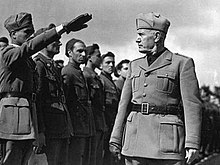
The Second Italo-Ethiopian War was a brief colonial war that began in October 1935 and ended in May 1936. The war began with the invasion of the Ethiopian Empire (also known as Abyssinia) by the armed forces of the Kingdom of Italy (Regno d'Italia), which was launched from Italian Somaliland and Eritrea.[17] The war resulted in the military occupation of Ethiopia and its annexation into the newly created colony of Italian East Africa (Africa Orientale Italiana, or AOI); in addition it exposed the weakness of the League of Nations as a force to preserve peace. Both Italy and Ethiopia were member nations, but the League did little when the former clearly violated Article X of the League's Covenant.[18] The United Kingdom and France supported imposing sanctions on Italy for the invasion, but the sanctions were not fully enforced and failed to end the Italian invasion.[19] Italy subsequently dropped its objections to Germany's goal of absorbing Austria.[20]
Spanish Civil War (1936–1939)
[edit]When civil war broke out in Spain, Hitler and Mussolini lent military support to the Nationalist rebels, led by General Francisco Franco. Italy supported the Nationalists to a greater extent than the Nazis: Mussolini sent more than 70,000 ground troops, 6,000 aviation personnel, and 720 aircraft to Spain.[21] The Soviet Union supported the existing government of the Spanish Republic. More than 30,000 foreign volunteers, known as the International Brigades, also fought against the Nationalists. Both Germany and the Soviet Union used this proxy war as an opportunity to test in combat their most advanced weapons and tactics. The Nationalists won the civil war in April 1939; Franco, now dictator, remained officially neutral during World War II but generally favoured the Axis.[22] His greatest collaboration with Germany was the sending of volunteers to fight on the Eastern Front.[23]
Japanese invasion of China (1937)
[edit]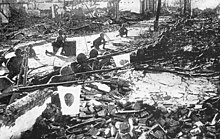
In July 1937, Japan captured the former Chinese imperial capital of Peking after instigating the Marco Polo Bridge incident, which culminated in the Japanese campaign to invade all of China.[24] The Soviets quickly signed a non-aggression pact with China to lend materiel support, effectively ending China's prior cooperation with Germany. From September to November, the Japanese attacked Taiyuan, engaged the Kuomintang Army around Xinkou,[25] and fought Communist forces in Pingxingguan.[26][27] Generalissimo Chiang Kai-shek deployed his best army to defend Shanghai, but after three months of fighting, Shanghai fell. The Japanese continued to push Chinese forces back, capturing the capital Nanking in December 1937. After the fall of Nanking, tens or hundreds of thousands of Chinese civilians and disarmed combatants were murdered by the Japanese.[28][29]
In March 1938, Nationalist Chinese forces won their first major victory at Taierzhuang, but then the city of Xuzhou was taken by the Japanese in May.[30] In June 1938, Chinese forces stalled the Japanese advance by flooding the Yellow River; this manoeuvre bought time for the Chinese to prepare their defences at Wuhan, but the city was taken by October.[31] Japanese military victories did not bring about the collapse of Chinese resistance that Japan had hoped to achieve; instead, the Chinese government relocated inland to Chongqing and continued the war.[32][33]
Soviet–Japanese border conflicts
[edit]In the mid-to-late 1930s, Japanese forces in Manchukuo had sporadic border clashes with the Soviet Union and Mongolia. The Japanese doctrine of Hokushin-ron, which emphasised Japan's expansion northward, was favoured by the Imperial Army during this time. This policy would prove difficult to maintain in light of the Japanese defeat at Khalkin Gol in 1939, the ongoing Second Sino-Japanese War[34] and ally Nazi Germany pursuing neutrality with the Soviets. Japan and the Soviet Union eventually signed a Neutrality Pact in April 1941, and Japan adopted the doctrine of Nanshin-ron, promoted by the Navy, which took its focus southward and eventually led to war with the United States and the Western Allies.[35][36]
European occupations and agreements
[edit]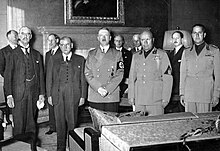
In Europe, Germany and Italy were becoming more aggressive. In March 1938, Germany annexed Austria, again provoking little response from other European powers.[37] Encouraged, Hitler began pressing German claims on the Sudetenland, an area of Czechoslovakia with a predominantly ethnic German population. Soon the United Kingdom and France followed the appeasement policy of British Prime Minister Neville Chamberlain and conceded this territory to Germany in the Munich Agreement, which was made against the wishes of the Czechoslovak government, in exchange for a promise of no further territorial demands.[38] Soon afterwards, Germany and Italy forced Czechoslovakia to cede additional territory to Hungary, and Poland annexed the Trans-Olza region of Czechoslovakia.[39]
Although all of Germany's stated demands had been satisfied by the agreement, privately Hitler was furious that British interference had prevented him from seizing all of Czechoslovakia in one operation. In subsequent speeches Hitler attacked British and Jewish "war-mongers" and in January 1939 secretly ordered a major build-up of the German navy to challenge British naval supremacy. In March 1939, Germany invaded the remainder of Czechoslovakia and subsequently split it into the German Protectorate of Bohemia and Moravia and a pro-German client state, the Slovak Republic.[40] Hitler also delivered an ultimatum to Lithuania on 20 March 1939, forcing the concession of the Klaipėda Region, formerly the German Memelland.[41]
Danzig Crisis
[edit]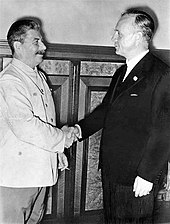
Greatly alarmed and with Hitler making further demands on the Free City of Danzig, the United Kingdom and France guaranteed their support for Polish independence; when Italy conquered Albania in April 1939, the same guarantee was extended to the Kingdoms of Romania and Greece.[42] Shortly after the Franco-British pledge to Poland, Germany and Italy formalised their own alliance with the Pact of Steel.[43] Hitler accused the United Kingdom and Poland of trying to "encircle" Germany and renounced the Anglo-German Naval Agreement and the German–Polish declaration of non-aggression.[44]
The situation became a crisis in late August as German troops continued to mobilise against the Polish border. On 23 August the Soviet Union signed a non-aggression pact with Germany,[45] after tripartite negotiations for a military alliance between France, the United Kingdom, and Soviet Union had stalled.[46] This pact had a secret protocol that defined German and Soviet "spheres of influence" (western Poland and Lithuania for Germany; eastern Poland, Finland, Estonia, Latvia and Bessarabia for the Soviet Union), and raised the question of continuing Polish independence.[47] The pact neutralised the possibility of Soviet opposition to a campaign against Poland and assured that Germany would not have to face the prospect of a two-front war, as it had in World War I. Immediately afterwards, Hitler ordered the attack to proceed on 26 August, but upon hearing that the United Kingdom had concluded a formal mutual assistance pact with Poland and that Italy would maintain neutrality, he decided to delay it.[48]
In response to British requests for direct negotiations to avoid war, Germany made demands on Poland, which served as a pretext to worsen relations.[49] On 29 August, Hitler demanded that a Polish plenipotentiary immediately travel to Berlin to negotiate the handover of Danzig, and to allow a plebiscite in the Polish Corridor in which the German minority would vote on secession.[49] The Poles refused to comply with the German demands, and on the night of 30–31 August in a confrontational meeting with the British ambassador Nevile Henderson, Ribbentrop declared that Germany considered its claims rejected.[50]
Course of the war
[edit]War breaks out in Europe (1939–1940)
[edit]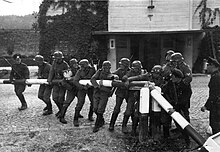
On 1 September 1939, Germany invaded Poland after having staged several false flag border incidents as a pretext to initiate the invasion.[51] The first German attack of the war came against the Polish defences at Westerplatte.[52] The United Kingdom responded with an ultimatum for Germany to cease military operations, and on 3 September, after the ultimatum was ignored, Britain and France declared war on Germany.[53] During the Phoney War period, the alliance provided no direct military support to Poland, outside of a cautious French probe into the Saarland.[54] The Western Allies also began a naval blockade of Germany, which aimed to damage the country's economy and war effort.[55] Germany responded by ordering U-boat warfare against Allied merchant and warships, which would later escalate into the Battle of the Atlantic.[56]
On 8 September, German troops reached the suburbs of Warsaw. The Polish counter-offensive to the west halted the German advance for several days, but it was outflanked and encircled by the Wehrmacht. Remnants of the Polish army broke through to besieged Warsaw. On 17 September 1939, two days after signing a cease-fire with Japan, the Soviet Union invaded Poland[57] under the supposed pretext that the Polish state had ceased to exist.[58] On 27 September, the Warsaw garrison surrendered to the Germans, and the last large operational unit of the Polish Army surrendered on 6 October. Despite the military defeat, Poland never surrendered; instead, it formed the Polish government-in-exile and a clandestine state apparatus remained in occupied Poland.[59] A significant part of Polish military personnel evacuated to Romania and Latvia; many of them later fought against the Axis in other theatres of the war.[60]
Germany annexed western Poland and occupied central Poland; the Soviet Union annexed eastern Poland; small shares of Polish territory were transferred to Lithuania and Slovakia. On 6 October, Hitler made a public peace overture to the United Kingdom and France but said that the future of Poland was to be determined exclusively by Germany and the Soviet Union. The proposal was rejected[50] and Hitler ordered an immediate offensive against France,[61] which was postponed until the spring of 1940 due to bad weather.[62][63][64]
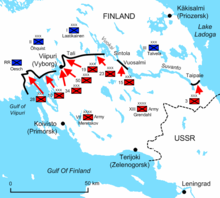
After the outbreak of war in Poland, Stalin threatened Estonia, Latvia, and Lithuania with military invasion, forcing the three Baltic countries to sign pacts allowing the creation of Soviet military bases in these countries; in October 1939, significant Soviet military contingents were moved there.[65][66][67] Finland refused to sign a similar pact and rejected ceding part of its territory to the Soviet Union. The Soviet Union invaded Finland in November 1939,[68] and was subsequently expelled from the League of Nations for this crime of aggression.[69] Despite overwhelming numerical superiority, Soviet military success during the Winter War was modest,[70] and the Finno-Soviet war ended in March 1940 with some Finnish concessions of territory.[71]
In June 1940, the Soviet Union occupied the entire territories of Estonia, Latvia and Lithuania,[66] as well as the Romanian regions of Bessarabia, Northern Bukovina, and the Hertsa region. In August 1940, Hitler imposed the Second Vienna Award on Romania which led to the transfer of Northern Transylvania to Hungary.[72] In September 1940, Bulgaria demanded Southern Dobruja from Romania with German and Italian support, leading to the Treaty of Craiova.[73] The loss of one-third of Romania's 1939 territory caused a coup against King Carol II, turning Romania into a fascist dictatorship under Marshal Ion Antonescu, with a course set towards the Axis in the hopes of a German guarantee.[74] Meanwhile, German-Soviet political relations and economic co-operation[75][76] gradually stalled,[77][78] and both states began preparations for war.[79]
Western Europe (1940–1941)
[edit]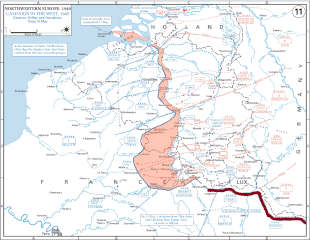
In April 1940, Germany invaded Denmark and Norway to protect shipments of iron ore from Sweden, which the Allies were attempting to cut off.[80] Denmark capitulated after six hours, and despite Allied support, Norway was conquered within two months.[81] British discontent over the Norwegian campaign led to the resignation of Prime Minister Neville Chamberlain, who was replaced by Winston Churchill on 10 May 1940.[82]
On the same day, Germany launched an offensive against France. To circumvent the strong Maginot Line fortifications on the Franco-German border, Germany directed its attack at the neutral nations of Belgium, the Netherlands, and Luxembourg.[83] The Germans carried out a flanking manoeuvre through the Ardennes region,[84] which was mistakenly perceived by the Allies as an impenetrable natural barrier against armoured vehicles.[85][86] By successfully implementing new Blitzkrieg tactics, the Wehrmacht rapidly advanced to the Channel and cut off the Allied forces in Belgium, trapping the bulk of the Allied armies in a cauldron on the Franco-Belgian border near Lille. The United Kingdom was able to evacuate a significant number of Allied troops from the continent by early June, although they had to abandon almost all their equipment.[87]
On 10 June, Italy invaded France, declaring war on both France and the United Kingdom.[88] The Germans turned south against the weakened French army, and Paris fell to them on 14 June. Eight days later France signed an armistice with Germany; it was divided into German and Italian occupation zones,[89] and an unoccupied rump state under the Vichy Regime, which, though officially neutral, was generally aligned with Germany. France kept its fleet, which the United Kingdom attacked on 3 July in an attempt to prevent its seizure by Germany.[90]
The air Battle of Britain[91] began in early July with Luftwaffe attacks on shipping and harbours.[92] The German campaign for air superiority started in August but its failure to defeat RAF Fighter Command forced the indefinite postponement of the proposed German invasion of Britain. The German strategic bombing offensive intensified with night attacks on London and other cities in the Blitz, but largely ended in May 1941[93] after failing to significantly disrupt the British war effort.[92]
Using newly captured French ports, the German Navy enjoyed success against an over-extended Royal Navy, using U-boats against British shipping in the Atlantic.[94] The British Home Fleet scored a significant victory on 27 May 1941 by sinking the German battleship Bismarck.[95]
In November 1939, the United States was assisting China and the Western Allies, and had amended the Neutrality Act to allow "cash and carry" purchases by the Allies.[96] In 1940, following the German capture of Paris, the size of the United States Navy was significantly increased. In September the United States further agreed to a trade of American destroyers for British bases.[97] Still, a large majority of the American public continued to oppose any direct military intervention in the conflict well into 1941.[98] In December 1940, Roosevelt accused Hitler of planning world conquest and ruled out any negotiations as useless, calling for the United States to become an "arsenal of democracy" and promoting Lend-Lease programmes of military and humanitarian aid to support the British war effort; Lend-Lease was later extended to the other Allies, including the Soviet Union after it was invaded by Germany.[99] The United States started strategic planning to prepare for a full-scale offensive against Germany.[100]
At the end of September 1940, the Tripartite Pact formally united Japan, Italy, and Germany as the Axis powers. The Tripartite Pact stipulated that any country—with the exception of the Soviet Union—that attacked any Axis Power would be forced to go to war against all three.[101] The Axis expanded in November 1940 when Hungary, Slovakia, and Romania joined.[102] Romania and Hungary later made major contributions to the Axis war against the Soviet Union, in Romania's case partially to recapture territory ceded to the Soviet Union.[103]
Mediterranean (1940–1941)
[edit]In early June 1940, the Italian Regia Aeronautica attacked and besieged Malta, a British possession. From late summer to early autumn, Italy conquered British Somaliland and made an incursion into British-held Egypt. In October, Italy attacked Greece, but the attack was repulsed with heavy Italian casualties; the campaign ended within months with minor territorial changes.[104] To assist Italy and prevent Britain from gaining a foothold, Germany prepared to invade the Balkans, which would threaten Romanian oil fields and strike against British dominance of the Mediterranean.[105]
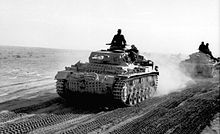
In December 1940, British Empire forces began counter-offensives against Italian forces in Egypt and Italian East Africa.[106] The offensives were successful; by early February 1941, Italy had lost control of eastern Libya, and large numbers of Italian troops had been taken prisoner. The Italian Navy also suffered significant defeats, with the Royal Navy putting three Italian battleships out of commission after a carrier attack at Taranto, and neutralising several more warships at the Battle of Cape Matapan.[107]
Italian defeats prompted Germany to deploy an expeditionary force to North Africa; at the end of March 1941, Rommel's Afrika Korps launched an offensive which drove back Commonwealth forces.[108] In less than a month, Axis forces advanced to western Egypt and besieged the port of Tobruk.[109]
By late March 1941, Bulgaria and Yugoslavia signed the Tripartite Pact; however, the Yugoslav government was overthrown two days later by pro-British nationalists. Germany and Italy responded with simultaneous invasions of both Yugoslavia and Greece, commencing on 6 April 1941; both nations were forced to surrender within the month.[110] The airborne invasion of the Greek island of Crete at the end of May completed the German conquest of the Balkans.[111] Partisan warfare subsequently broke out against the Axis occupation of Yugoslavia, which continued until the end of the war.[112]
In the Middle East in May, Commonwealth forces quashed an uprising in Iraq which had been supported by German aircraft from bases within Vichy-controlled Syria.[113] Between June and July, British-led forces invaded and occupied the French possessions of Syria and Lebanon, assisted by the Free French.[114]
Axis attack on the Soviet Union (1941)
[edit]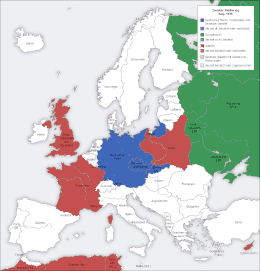
With the situation in Europe and Asia relatively stable, Germany, Japan, and the Soviet Union made preparations for war. With the Soviets wary of mounting tensions with Germany, and the Japanese planning to take advantage of the European War by seizing resource-rich European possessions in Southeast Asia, the two powers signed the Soviet–Japanese Neutrality Pact in April 1941.[115] By contrast, the Germans were steadily making preparations for an attack on the Soviet Union, massing forces on the Soviet border.[116]
Hitler believed that the United Kingdom's refusal to end the war was based on the hope that the United States and the Soviet Union would enter the war against Germany sooner or later.[117] On 31 July 1940, Hitler decided that the Soviet Union should be eliminated and aimed for the conquest of Ukraine, the Baltic states and Byelorussia.[118] However, other senior German officials like Ribbentrop saw an opportunity to create a Euro-Asian bloc against the British Empire by inviting the Soviet Union into the Tripartite Pact.[119] In November 1940, negotiations took place to determine if the Soviet Union would join the pact. The Soviets showed some interest but asked for concessions from Finland, Bulgaria, Turkey, and Japan that Germany considered unacceptable. On 18 December 1940, Hitler issued the directive to prepare for an invasion of the Soviet Union.[120]
On 22 June 1941, Germany, supported by Italy and Romania, invaded the Soviet Union in Operation Barbarossa, with Germany accusing the Soviets of plotting against them; they were joined shortly by Finland and Hungary.[121] The primary targets of this surprise offensive[122] were the Baltic region, Moscow and Ukraine, with the ultimate goal of ending the 1941 campaign near the Arkhangelsk-Astrakhan line—from the Caspian to the White Seas. Hitler's objectives were to eliminate the Soviet Union as a military power, exterminate Communism, generate Lebensraum ("living space")[123] by dispossessing the native population,[124] and guarantee access to the strategic resources needed to defeat Germany's remaining rivals.[125]
Although the Red Army was preparing for strategic counter-offensives before the war,[126] Operation Barbarossa forced the Soviet supreme command to adopt strategic defence. During the summer, the Axis made significant gains into Soviet territory, inflicting immense losses in both personnel and materiel. By mid-August, however, the German Army High Command decided to suspend the offensive of a considerably depleted Army Group Centre, and to divert the 2nd Panzer Group to reinforce troops advancing towards central Ukraine and Leningrad.[127] The Kiev offensive was overwhelmingly successful, resulting in encirclement and elimination of four Soviet armies, and made possible further advance into Crimea and industrially-developed Eastern Ukraine (the First Battle of Kharkov).[128]
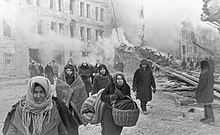
The diversion of three-quarters of the Axis troops and the majority of their air forces from France and the central Mediterranean to the Eastern Front[129] prompted the United Kingdom to reconsider its grand strategy.[130] In July, the UK and the Soviet Union formed a military alliance against Germany[131] and in August, the United Kingdom and the United States jointly issued the Atlantic Charter, which outlined British and American goals for the post-war world.[132] In late August the British and Soviets invaded neutral Iran to secure the Persian Corridor, Iran's oil fields, and preempt any Axis advances through Iran toward the Baku oil fields or India.[133]
By October, Axis powers had achieved operational objectives in Ukraine and the Baltic region, with only the sieges of Leningrad[134] and Sevastopol continuing.[135] A major offensive against Moscow was renewed; after two months of fierce battles in increasingly harsh weather, the German army almost reached the outer suburbs of Moscow, where the exhausted troops[136] were forced to suspend the offensive.[137] Large territorial gains were made by Axis forces, but their campaign had failed to achieve its main objectives: two key cities remained in Soviet hands, the Soviet capability to resist was not broken, and the Soviet Union retained a considerable part of its military potential. The blitzkrieg phase of the war in Europe had ended.[138]
By early December, freshly mobilised reserves[139] allowed the Soviets to achieve numerical parity with Axis troops.[140] This, as well as intelligence data which established that a minimal number of Soviet troops in the East would be sufficient to deter any attack by the Japanese Kwantung Army,[141] allowed the Soviets to begin a massive counter-offensive that started on 5 December all along the front and pushed German troops 100–250 kilometres (62–155 mi) west.[142]
War breaks out in the Pacific (1941)
[edit]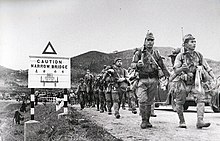
Following the Japanese false flag Mukden incident in 1931, the Japanese shelling of the American gunboat USS Panay in 1937, and the 1937–1938 Nanjing Massacre, Japanese-American relations deteriorated. In 1939, the United States notified Japan that it would not be extending its trade treaty and American public opinion opposing Japanese expansionism led to a series of economic sanctions—the Export Control Acts—which banned U.S. exports of chemicals, minerals and military parts to Japan, and increased economic pressure on the Japanese regime.[99][143][144] During 1939 Japan launched its first attack against Changsha, but was repulsed by late September.[145] Despite several offensives by both sides, by 1940 the war between China and Japan was at a stalemate. To increase pressure on China by blocking supply routes, and to better position Japanese forces in the event of a war with the Western powers, Japan invaded and occupied northern Indochina in September 1940.[146]
Chinese nationalist forces launched a large-scale counter-offensive in early 1940. In August, Chinese communists launched an offensive in Central China; in retaliation, Japan instituted harsh measures in occupied areas to reduce human and material resources for the communists.[147] Continued antipathy between Chinese communist and nationalist forces culminated in armed clashes in January 1941, effectively ending their co-operation.[148] In March, the Japanese 11th army attacked the headquarters of the Chinese 19th army but was repulsed during Battle of Shanggao.[149] In September, Japan attempted to take the city of Changsha again and clashed with Chinese nationalist forces.[150]
German successes in Europe prompted Japan to increase pressure on European governments in Southeast Asia. The Dutch government agreed to provide Japan with oil supplies from the Dutch East Indies, but negotiations for additional access to their resources ended in failure in June 1941.[151] In July 1941 Japan sent troops to southern Indochina, thus threatening British and Dutch possessions in the Far East. The United States, the United Kingdom, and other Western governments reacted to this move with a freeze on Japanese assets and a total oil embargo.[152][153] At the same time, Japan was planning an invasion of the Soviet Far East, intending to take advantage of the German invasion in the west, but abandoned the operation after the sanctions.[154]
Since early 1941, the United States and Japan had been engaged in negotiations in an attempt to improve their strained relations and end the war in China. During these negotiations, Japan advanced a number of proposals which were dismissed by the Americans as inadequate.[155] At the same time the United States, the United Kingdom, and the Netherlands engaged in secret discussions for the joint defence of their territories, in the event of a Japanese attack against any of them.[156] Roosevelt reinforced the Philippines (an American protectorate scheduled for independence in 1946) and warned Japan that the United States would react to Japanese attacks against any "neighboring countries".[156]
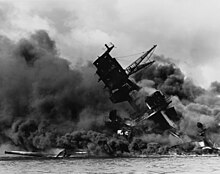
Frustrated at the lack of progress and feeling the pinch of the American–British–Dutch sanctions, Japan prepared for war. Emperor Hirohito, after initial hesitation about Japan's chances of victory,[157] began to favour Japan's entry into the war.[158] As a result, Prime Minister Fumimaro Konoe resigned.[159][160] Hirohito refused the recommendation to appoint Prince Naruhiko Higashikuni in his place, choosing War Minister Hideki Tojo instead.[161] On 3 November, Nagano explained in detail the plan of the attack on Pearl Harbor to the Emperor.[162] On 5 November, Hirohito approved in imperial conference the operations plan for the war.[163] On 20 November, the new government presented an interim proposal as its final offer. It called for the end of American aid to China and for lifting the embargo on the supply of oil and other resources to Japan. In exchange, Japan promised not to launch any attacks in Southeast Asia and to withdraw its forces from southern Indochina.[155] The American counter-proposal of 26 November required that Japan evacuate all of China without conditions and conclude non-aggression pacts with all Pacific powers.[164] That meant Japan was essentially forced to choose between abandoning its ambitions in China, or seizing the natural resources it needed in the Dutch East Indies by force;[165][166] the Japanese military did not consider the former an option, and many officers considered the oil embargo an unspoken declaration of war.[167]
Japan planned to seize European colonies in Asia to create a large defensive perimeter stretching into the Central Pacific. The Japanese would then be free to exploit the resources of Southeast Asia while exhausting the over-stretched Allies by fighting a defensive war.[168][169] To prevent American intervention while securing the perimeter, it was further planned to neutralise the United States Pacific Fleet and the American military presence in the Philippines from the outset.[170] On 7 December 1941 (8 December in Asian time zones), Japan attacked British and American holdings with near-simultaneous offensives against Southeast Asia and the Central Pacific.[171] These included an attack on the American fleets at Pearl Harbor and the Philippines, as well as invasions of Guam, Wake Island, Malaya,[171] Thailand, and Hong Kong.[172]
These attacks led the United States, United Kingdom, China, Australia, and several other states to formally declare war on Japan, whereas the Soviet Union, being heavily involved in large-scale hostilities with European Axis countries, maintained its neutrality agreement with Japan.[173] Germany, followed by the other Axis states, declared war on the United States[174] in solidarity with Japan, citing as justification the American attacks on German war vessels that had been ordered by Roosevelt.[121][175]
Axis advance stalls (1942–1943)
[edit]On 1 January 1942, the Allied Big Four[176]—the Soviet Union, China, the United Kingdom, and the United States—and 22 smaller or exiled governments issued the Declaration by United Nations, thereby affirming the Atlantic Charter[177] and agreeing not to sign a separate peace with the Axis powers.[178]
During 1942, Allied officials debated on the appropriate grand strategy to pursue. All agreed that defeating Germany was the primary objective. The Americans favoured a straightforward, large-scale attack on Germany through France. The Soviets demanded a second front. The British argued that military operations should target peripheral areas to wear out German strength, leading to increasing demoralisation, and bolstering resistance forces; Germany itself would be subject to a heavy bombing campaign. An offensive against Germany would then be launched primarily by Allied armour, without using large-scale armies.[179] Eventually, the British persuaded the Americans that a landing in France was infeasible in 1942 and they should instead focus on driving the Axis out of North Africa.[180]
At the Casablanca Conference in early 1943, the Allies reiterated the statements issued in the 1942 Declaration and demanded the unconditional surrender of their enemies. The British and Americans agreed to continue to press the initiative in the Mediterranean by invading Sicily to fully secure the Mediterranean supply routes.[181] Although the British argued for further operations in the Balkans to bring Turkey into the war, in May 1943, the Americans extracted a British commitment to limit Allied operations in the Mediterranean to an invasion of the Italian mainland, and to invade France in 1944.[182]
Pacific (1942–1943)
[edit]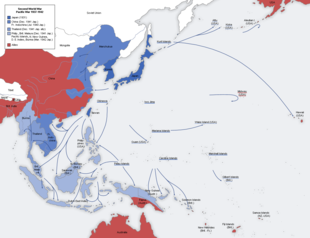
By the end of April 1942, Japan and its ally Thailand had almost conquered Burma, Malaya, the Dutch East Indies, Singapore, and Rabaul, inflicting severe losses on Allied troops and taking a large number of prisoners.[183] Despite stubborn resistance by Filipino and U.S. forces, the Philippine Commonwealth was eventually captured in May 1942, forcing its government into exile.[184] On 16 April, in Burma, 7,000 British soldiers were encircled by the Japanese 33rd Division during the Battle of Yenangyaung and rescued by the Chinese 38th Division.[185] Japanese forces also achieved naval victories in the South China Sea, Java Sea, and Indian Ocean,[186] and bombed the Allied naval base at Darwin, Australia. In January 1942, the only Allied success against Japan was a Chinese victory at Changsha.[187] These easy victories over the unprepared U.S. and European opponents left Japan overconfident, and overextended.[188]
In early May 1942, Japan initiated operations to capture Port Moresby by amphibious assault and thus sever communications and supply lines between the United States and Australia. The planned invasion was thwarted when an Allied task force, centred on two American fleet carriers, fought Japanese naval forces to a draw in the Battle of the Coral Sea.[189] Japan's next plan, motivated by the earlier Doolittle Raid, was to seize Midway Atoll and lure American carriers into battle to be eliminated; as a diversion, Japan would also send forces to occupy the Aleutian Islands in Alaska.[190] In mid-May, Japan started the Zhejiang-Jiangxi campaign in China, with the goal of inflicting retribution on the Chinese who aided the surviving American airmen in the Doolittle Raid by destroying Chinese air bases and fighting against the Chinese 23rd and 32nd Army Groups.[191][192] In early June, Japan put its operations into action, but the Americans had broken Japanese naval codes in late May and were fully aware of the plans and order of battle, and used this knowledge to achieve a decisive victory at Midway over the Imperial Japanese Navy.[193]
With its capacity for aggressive action greatly diminished as a result of the Midway battle, Japan attempted to capture Port Moresby by an overland campaign in the Territory of Papua.[194] The Americans planned a counterattack against Japanese positions in the southern Solomon Islands, primarily Guadalcanal, as a first step towards capturing Rabaul, the main Japanese base in Southeast Asia.[195]
Both plans started in July, but by mid-September, the Battle for Guadalcanal took priority for the Japanese, and troops in New Guinea were ordered to withdraw from the Port Moresby area to the northern part of the island, where they faced Australian and United States troops in the Battle of Buna–Gona.[196] Guadalcanal soon became a focal point for both sides with heavy commitments of troops and ships in the battle for Guadalcanal. By the start of 1943, the Japanese were defeated on the island and withdrew their troops.[197] In Burma, Commonwealth forces mounted two operations. The first was a disastrous offensive into the Arakan region in late 1942 that forced a retreat back to India by May 1943.[198] The second was the insertion of irregular forces behind Japanese frontlines in February which, by the end of April, had achieved mixed results.[199]
Eastern Front (1942–1943)
[edit]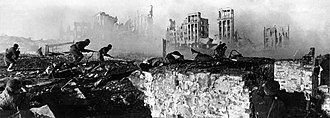
Despite considerable losses, in early 1942 Germany and its allies stopped a major Soviet offensive in central and southern Russia, keeping most territorial gains they had achieved during the previous year.[200] In May, the Germans defeated Soviet offensives in the Kerch Peninsula and at Kharkov,[201] and then in June 1942 launched their main summer offensive against southern Russia, to seize the oil fields of the Caucasus and occupy the Kuban steppe, while maintaining positions on the northern and central areas of the front. The Germans split Army Group South into two groups: Army Group A advanced to the lower Don River and struck south-east to the Caucasus, while Army Group B headed towards the Volga River. The Soviets decided to make their stand at Stalingrad on the Volga.[202]
By mid-November, the Germans had nearly taken Stalingrad in bitter street fighting. The Soviets began their second winter counter-offensive, starting with an encirclement of German forces at Stalingrad,[203] and an assault on the Rzhev salient near Moscow, though the latter failed disastrously.[204] By early February 1943, the German Army had taken tremendous losses; German troops at Stalingrad had been defeated,[205] and the front-line had been pushed back beyond its position before the summer offensive. In mid-February, after the Soviet push had tapered off, the Germans launched another attack on Kharkov, creating a salient in their front line around the Soviet city of Kursk.[206]
Western Europe/Atlantic and Mediterranean (1942–1943)
[edit]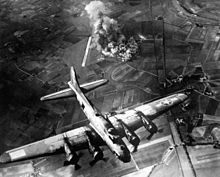
Exploiting poor American naval command decisions, the German navy ravaged Allied shipping off the American Atlantic coast.[207] By November 1941, Commonwealth forces had launched a counter-offensive in North Africa, Operation Crusader, and reclaimed all the gains the Germans and Italians had made.[208] The Germans also launched a North African offensive in January, pushing the British back to positions at the Gazala line by early February,[209] followed by a temporary lull in combat which Germany used to prepare for their upcoming offensives.[210] Concerns that the Japanese might use bases in Vichy-held Madagascar caused the British to invade the island in early May 1942.[211] An Axis offensive in Libya forced an Allied retreat deep inside Egypt until Axis forces were stopped at El Alamein.[212] On the Continent, raids of Allied commandos on strategic targets, culminating in the failed Dieppe Raid,[213] demonstrated the Western Allies' inability to launch an invasion of continental Europe without much better preparation, equipment, and operational security.[214]
In August 1942, the Allies succeeded in repelling a second attack against El Alamein[215] and, at a high cost, managed to deliver desperately needed supplies to the besieged Malta.[216] A few months later, the Allies commenced an attack of their own in Egypt, dislodging the Axis forces and beginning a drive west across Libya.[217] This attack was followed up shortly after by Anglo-American landings in French North Africa, which resulted in the region joining the Allies.[218] Hitler responded to the French colony's defection by ordering the occupation of Vichy France;[218] although Vichy forces did not resist this violation of the armistice, they managed to scuttle their fleet to prevent its capture by German forces.[218][219] Axis forces in Africa withdrew into Tunisia, which was conquered by the Allies in May 1943.[218][220]
In June 1943, the British and Americans began a strategic bombing campaign against Germany with a goal to disrupt the war economy, reduce morale, and "de-house" the civilian population.[221] The firebombing of Hamburg was among the first attacks in this campaign, inflicting significant casualties and considerable losses on infrastructure of this important industrial centre.[222]
Allies gain momentum (1943–1944)
[edit]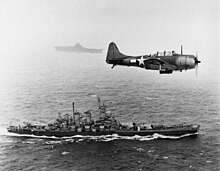
After the Guadalcanal campaign, the Allies initiated several operations against Japan in the Pacific. In May 1943, Canadian and U.S. forces were sent to eliminate Japanese forces from the Aleutians.[223] Soon after, the United States, with support from Australia, New Zealand and Pacific Islander forces, began major ground, sea and air operations to isolate Rabaul by capturing surrounding islands, and breach the Japanese Central Pacific perimeter at the Gilbert and Marshall Islands.[224] By the end of March 1944, the Allies had completed both of these objectives and had also neutralised the major Japanese base at Truk in the Caroline Islands. In April, the Allies launched an operation to retake Western New Guinea.[225]
In the Soviet Union, both the Germans and the Soviets spent the spring and early summer of 1943 preparing for large offensives in central Russia. On 5 July 1943, Germany attacked Soviet forces around the Kursk Bulge. Within a week, German forces had exhausted themselves against the Soviets' well-constructed defences,[226] and for the first time in the war, Hitler cancelled an operation before it had achieved tactical or operational success.[227] This decision was partially affected by the Western Allies' invasion of Sicily launched on 9 July, which, combined with previous Italian failures, resulted in the ousting and arrest of Mussolini later that month.[228]
On 12 July 1943, the Soviets launched their own counter-offensives, thereby dispelling any chance of German victory or even stalemate in the east. The Soviet victory at Kursk marked the end of German superiority,[229] giving the Soviet Union the initiative on the Eastern Front.[230][231] The Germans tried to stabilise their eastern front along the hastily fortified Panther–Wotan line, but the Soviets broke through it at Smolensk and the Lower Dnieper Offensive.[232]
On 3 September 1943, the Western Allies invaded the Italian mainland, following Italy's armistice with the Allies and the ensuing German occupation of Italy.[233] Germany, with the help of fascists, responded to the armistice by disarming Italian forces that were in many places without superior orders, seizing military control of Italian areas,[234] and creating a series of defensive lines.[235] German special forces then rescued Mussolini, who then soon established a new client state in German-occupied Italy named the Italian Social Republic,[236] causing an Italian civil war. The Western Allies fought through several lines until reaching the main German defensive line in mid-November.[237]
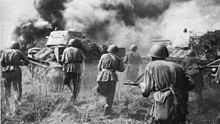
German operations in the Atlantic also suffered. By May 1943, as Allied counter-measures became increasingly effective, the resulting sizeable German submarine losses forced a temporary halt of the German Atlantic naval campaign.[238] In November 1943, Franklin D. Roosevelt and Winston Churchill met with Chiang Kai-shek in Cairo and then with Joseph Stalin in Tehran.[239] The former conference determined the post-war return of Japanese territory[240] and the military planning for the Burma campaign,[241] while the latter included agreement that the Western Allies would invade Europe in 1944 and that the Soviet Union would declare war on Japan within three months of Germany's defeat.[242]
From November 1943, during the seven-week Battle of Changde, the Chinese awaited allied relief as they forced Japan to fight a costly war of attrition.[243][244][245] In January 1944, the Allies launched a series of attacks in Italy against the line at Monte Cassino and tried to outflank it with landings at Anzio.[246]
On 27 January 1944, Soviet troops launched a major offensive that expelled German forces from the Leningrad region, thereby ending the most lethal siege in history.[247] The following Soviet offensive was halted on the pre-war Estonian border by the German Army Group North aided by Estonians hoping to re-establish national independence. This delay slowed subsequent Soviet operations in the Baltic Sea region.[248] By late May 1944, the Soviets had liberated Crimea, largely expelled Axis forces from Ukraine, and made incursions into Romania, which were repulsed by the Axis troops.[249] The Allied offensives in Italy had succeeded and, at the expense of allowing several German divisions to retreat, Rome was captured on 4 June.[250]
The Allies had mixed success in mainland Asia. In March 1944, the Japanese launched the first of two invasions, an operation against Allied positions in Assam, India,[251] and soon besieged Commonwealth positions at Imphal and Kohima.[252] In May 1944, British and Indian forces mounted a counter-offensive that drove Japanese troops back to Burma by July,[252] and Chinese forces that had invaded northern Burma in late 1943 besieged Japanese troops in Myitkyina.[253] The second Japanese invasion of China aimed to destroy China's main fighting forces, secure railways between Japanese-held territory and capture Allied airfields.[254] By June, the Japanese had conquered the province of Henan and begun a new attack on Changsha.[255]
Allies close in (1944)
[edit]
On 6 June 1944 (commonly known as D-Day), after three years of Soviet pressure,[256] the Western Allies invaded northern France. After reassigning several Allied divisions from Italy, they also attacked southern France.[257] These landings were successful and led to the defeat of the German Army units in France. Paris was liberated on 25 August by the local resistance assisted by the Free French Forces, both led by General Charles de Gaulle,[258] and the Western Allies continued to push back German forces in western Europe during the latter part of the year. An attempt to advance into northern Germany spearheaded by a major airborne operation in the Netherlands failed.[259] After that, the Western Allies slowly pushed into Germany, but failed to cross the Ruhr river. In Italy, the Allied advance slowed due to the last major German defensive line.[260]
On 22 June, the Soviets launched a strategic offensive in Belarus ("Operation Bagration") that nearly destroyed the German Army Group Centre.[261] Soon after that, another Soviet strategic offensive forced German troops from Western Ukraine and Eastern Poland. The Soviets formed the Polish Committee of National Liberation to control territory in Poland and combat the Polish Armia Krajowa; the Soviet Red Army remained in the Praga district on the other side of the Vistula and watched passively as the Germans quelled the Warsaw Uprising initiated by the Armia Krajowa.[262] The national uprising in Slovakia was also quelled by the Germans.[263] The Soviet Red Army's strategic offensive in eastern Romania cut off and destroyed the considerable German troops there and triggered a successful coup d'état in Romania and in Bulgaria, followed by those countries' shift to the Allied side.[264]
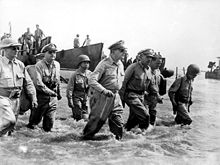
In September 1944, Soviet troops advanced into Yugoslavia and forced the rapid withdrawal of German Army Groups E and F in Greece, Albania and Yugoslavia to rescue them from being cut off.[265] By this point, the communist-led Partisans under Marshal Josip Broz Tito, who had led an increasingly successful guerrilla campaign against the occupation since 1941, controlled much of the territory of Yugoslavia and engaged in delaying efforts against German forces further south. In northern Serbia, the Soviet Red Army, with limited support from Bulgarian forces, assisted the Partisans in a joint liberation of the capital city of Belgrade on 20 October. A few days later, the Soviets launched a massive assault against German-occupied Hungary that lasted until the fall of Budapest in February 1945.[266] Unlike impressive Soviet victories in the Balkans, bitter Finnish resistance to the Soviet offensive in the Karelian Isthmus denied the Soviets occupation of Finland and led to a Soviet-Finnish armistice on relatively mild conditions,[267] although Finland was forced to fight their former German allies.[268]
By the start of July 1944, Commonwealth forces in Southeast Asia had repelled the Japanese sieges in Assam, pushing the Japanese back to the Chindwin River[269] while the Chinese captured Myitkyina. In September 1944, Chinese forces captured Mount Song and reopened the Burma Road.[270] In China, the Japanese had more successes, having finally captured Changsha in mid-June and the city of Hengyang by early August.[271] Soon after, they invaded the province of Guangxi, winning major engagements against Chinese forces at Guilin and Liuzhou by the end of November[272] and successfully linking up their forces in China and Indochina by mid-December.[273]
In the Pacific, U.S. forces continued to push back the Japanese perimeter. In mid-June 1944, they began their offensive against the Mariana and Palau islands and decisively defeated Japanese forces in the Battle of the Philippine Sea. These defeats led to the resignation of the Japanese Prime Minister, Hideki Tojo, and provided the United States with air bases to launch intensive heavy bomber attacks on the Japanese home islands. In late October, American forces invaded the Filipino island of Leyte; soon after, Allied naval forces scored another large victory in the Battle of Leyte Gulf, one of the largest naval battles in history.[274]
Axis collapse and Allied victory (1944–1945)
[edit]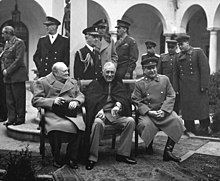
On 16 December 1944, Germany made a last attempt to split the Allies on the Western Front by using most of its remaining reserves to launch a massive counter-offensive in the Ardennes and along the French-German border, hoping to encircle large portions of Western Allied troops and prompt a political settlement after capturing their primary supply port at Antwerp. By 16 January 1945, this offensive had been repulsed with no strategic objectives fulfilled.[275] In Italy, the Western Allies remained stalemated at the German defensive line. In mid-January 1945, the Red Army attacked in Poland, pushing from the Vistula to the Oder river in Germany, and overran East Prussia.[276] On 4 February Soviet, British, and U.S. leaders met for the Yalta Conference. They agreed on the occupation of post-war Germany, and on when the Soviet Union would join the war against Japan.[277]
In February, the Soviets entered Silesia and Pomerania, while the Western Allies entered western Germany and closed to the Rhine river. By March, the Western Allies crossed the Rhine north and south of the Ruhr, encircling the German Army Group B.[278] In early March, in an attempt to protect its last oil reserves in Hungary and retake Budapest, Germany launched its last major offensive against Soviet troops near Lake Balaton. Within two weeks, the offensive had been repulsed, the Soviets advanced to Vienna, and captured the city. In early April, Soviet troops captured Königsberg, while the Western Allies finally pushed forward in Italy and swept across western Germany capturing Hamburg and Nuremberg. American and Soviet forces met at the Elbe river on 25 April, leaving unoccupied pockets in southern Germany and around Berlin.
Soviet troops stormed and captured Berlin in late April.[279] In Italy, German forces surrendered on 29 April, while the Italian Social Republic capitulated two days later. On 30 April, the Reichstag was captured, signalling the military defeat of Nazi Germany.[280]
Major changes in leadership occurred on both sides during this period. On 12 April, President Roosevelt died and was succeeded by his vice president, Harry S. Truman. Benito Mussolini was killed by Italian partisans on 28 April.[281] On 30 April, Hitler committed suicide in his headquarters, and was succeeded by Grand Admiral Karl Dönitz (as President of the Reich) and Joseph Goebbels (as Chancellor of the Reich); Goebbels also committed suicide on the following day and was replaced by Lutz Graf Schwerin von Krosigk, in what would later be known as the Flensburg Government. Total and unconditional surrender in Europe was signed on 7 and 8 May, to be effective by the end of 8 May.[282] German Army Group Centre resisted in Prague until 11 May.[283] On 23 May all remaining members of the German government were arrested by the Allied Forces in Flensburg, while on 5 June all German political and military institutions were transferred under the control of the Allies through the Berlin Declaration.[284]
In the Pacific theatre, American forces accompanied by the forces of the Philippine Commonwealth advanced in the Philippines, clearing Leyte by the end of April 1945. They landed on Luzon in January 1945 and recaptured Manila in March. Fighting continued on Luzon, Mindanao, and other islands of the Philippines until the end of the war.[285] Meanwhile, the United States Army Air Forces launched a massive firebombing campaign of strategic cities in Japan in an effort to destroy Japanese war industry and civilian morale. A devastating bombing raid on Tokyo of 9–10 March was the deadliest conventional bombing raid in history.[286]
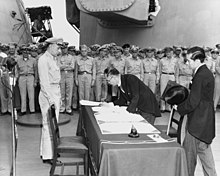
In May 1945, Australian troops landed in Borneo, overrunning the oilfields there. British, American, and Chinese forces defeated the Japanese in northern Burma in March, and the British pushed on to reach Rangoon by 3 May.[287] Chinese forces started a counterattack in the Battle of West Hunan that occurred between 6 April and 7 June 1945. American naval and amphibious forces also moved towards Japan, taking Iwo Jima by March, and Okinawa by the end of June.[288] At the same time, a naval blockade by submarines was strangling Japan's economy and drastically reducing its ability to supply overseas forces.[289][290]
On 11 July, Allied leaders met in Potsdam, Germany. They confirmed earlier agreements about Germany,[291] and the American, British and Chinese governments reiterated the demand for unconditional surrender of Japan, specifically stating that "the alternative for Japan is prompt and utter destruction".[292] During this conference, the United Kingdom held its general election, and Clement Attlee replaced Churchill as Prime Minister.[293]
The call for unconditional surrender was rejected by the Japanese government, which believed it would be capable of negotiating for more favourable surrender terms.[294] In early August, the United States dropped atomic bombs on the Japanese cities of Hiroshima and Nagasaki. Between the two bombings, the Soviets, pursuant to the Yalta agreement, declared war on Japan, invaded Japanese-held Manchuria and quickly defeated the Kwantung Army, which was the largest Japanese fighting force.[295] These two events persuaded previously adamant Imperial Army leaders to accept surrender terms.[296] The Red Army also captured the southern part of Sakhalin Island and the Kuril Islands. On the night of 9–10 August 1945, Emperor Hirohito announced his decision to accept the terms demanded by the Allies in the Potsdam Declaration.[297] On 15 August, the Emperor communicated this decision to the Japanese people through a speech broadcast on the radio (Gyokuon-hōsō, literally "broadcast in the Emperor's voice").[298] On 15 August 1945, Japan surrendered, with the surrender documents finally signed at Tokyo Bay on the deck of the American battleship USS Missouri on 2 September 1945, ending the war.[299]
References
[edit]- ^ Mintz, Steven. "Historical Context: The Global Effect of World War I". The Gilder Lehrman Institute of American History. Archived from the original on 4 March 2024. Retrieved 4 March 2024.
- ^ Gerwarth, Robert. "Paris Peace Treaties failed to create a secure, peaceful and lasting world order". The Irish Times. Archived from the original on 14 August 2021. Retrieved 29 October 2021.
- ^ Ingram 2006, pp. 76–78.
- ^ Kantowicz 1999, p. 149.
- ^ Shaw 2000, p. 35.
- ^ Brody 1999, p. 4.
- ^ Zalampas 1989, p. 62.
- ^ Mandelbaum 1988, p. 96; Record 2005, p. 50.
- ^ Schmitz 2000, p. 124.
- ^ Adamthwaite 1992, p. 52.
- ^ Shirer 1990, pp. 298–299.
- ^ Preston 1998, p. 104.
- ^ Myers & Peattie 1987, p. 458.
- ^ Smith & Steadman 2004, p. 28.
- ^ Coogan 1993: "Although some Chinese troops in the Northeast managed to retreat south, others were trapped by the advancing Japanese Army and were faced with the choice of resistance in defiance of orders, or surrender. A few commanders submitted, receiving high office in the puppet government, but others took up arms against the invader. The forces they commanded were the first of the volunteer armies."
- ^ Busky 2002, p. 10.
- ^ Andrea L. Stanton; Edward Ramsamy; Peter J. Seybolt (2012). Cultural Sociology of the Middle East, Asia, and Africa: An Encyclopedia. p. 308. ISBN 978-1-4129-8176-7. Archived from the original on 7 March 2023. Retrieved 6 April 2014.
- ^ Barker 1971, pp. 131–132.
- ^ Shirer 1990, p. 289.
- ^ Kitson 2001, p. 231.
- ^ Neulen 2000, p. 25.
- ^ Payne 2008, p. 271.
- ^ Payne 2008, p. 146.
- ^ Eastman 1986, pp. 547–551.
- ^ Hsu & Chang 1971, pp. 195–200.
- ^ Tucker, Spencer C. (2009). A Global Chronology of Conflict: From the Ancient World to the Modern Middle East [6 volumes]: From the Ancient World to the Modern Middle East. ABC-CLIO. ISBN 978-1-85109-672-5. Archived from the original on 7 March 2023. Retrieved 27 August 2017 – via Google Books.
- ^ Yang Kuisong, "On the reconstruction of the facts of the Battle of Pingxingguan"
- ^ Levene, Mark and Roberts, Penny. The Massacre in History. 1999, pp. 223–224
- ^ Totten, Samuel. Dictionary of Genocide. 2008, 298–299.
- ^ Hsu & Chang 1971, pp. 221–230.
- ^ Eastman 1986, p. 566.
- ^ Taylor 2009, pp. 150–152.
- ^ Sella 1983, pp. 651–687.
- ^ Beevor 2012, p. 342.
- ^ Goldman, Stuart D. (28 August 2012). "The Forgotten Soviet-Japanese War of 1939". The Diplomat. Archived from the original on 29 June 2015. Retrieved 26 June 2015.
- ^ Timothy Neeno. "Nomonhan: The Second Russo-Japanese War". MilitaryHistoryOnline.com. Archived from the original on 24 November 2005. Retrieved 26 June 2015.
- ^ Collier & Pedley 2000, p. 144.
- ^ Kershaw 2001, pp. 121–122.
- ^ Kershaw 2001, p. 157.
- ^ Davies 2006, pp. 143–144 (2008 ed.).
- ^ Shirer 1990, pp. 461–462.
- ^ Lowe & Marzari 2002, p. 330.
- ^ Dear & Foot 2001, p. 234.
- ^ Shirer 1990, p. 471.
- ^ Shore 2003, p. 108.
- ^ Watson, Derek (2000). "Molotov's Apprenticeship in Foreign Policy: The Triple Alliance Negotiations in 1939". Europe-Asia Studies. 52 (4): 695–722. doi:10.1080/713663077. JSTOR 153322. S2CID 144385167.
- ^ Dear & Foot 2001, p. 608.
- ^ "The German Campaign In Poland (1939)". Archived from the original on 24 May 2014. Retrieved 29 October 2014.
- ^ a b "The Danzig Crisis". ww2db.com. Archived from the original on 5 May 2016. Retrieved 29 April 2016.
- ^ a b "Major international events of 1939, with explanation". Ibiblio.org. Archived from the original on 10 March 2013. Retrieved 9 May 2013.
- ^ Evans 2008, pp. 1–2.
- ^ David T. Zabecki (2015). World War II in Europe: An Encyclopedia. Routledge. p. 1663. ISBN 978-1-135-81242-3. Archived from the original on 7 March 2023. Retrieved 17 June 2019.
The earliest fighting started at 0445 hours when marines from the battleship Schleswig-Holstein attempted to storm a small Polish fort in Danzig, the Westerplate
- ^ The UK declared war on Germany at 11 am. France followed 6 hours later at 5 pm.
- ^ Keegan 1997, p. 35.
Cienciala 2010, p. 128, observes that, while it is true that Poland was far away, making it difficult for the French and British to provide support, "[f]ew Western historians of World War II ... know that the British had committed to bomb Germany if it attacked Poland, but did not do so except for one raid on the base of Wilhelmshaven. The French, who committed to attacking Germany in the west, had no intention of doing so." - ^ Beevor 2012, p. 32; Dear & Foot 2001, pp. 248–249; Roskill 1954, p. 64.
- ^ "Battle of the Atlantic". Sky HISTORY TV channel. Archived from the original on 20 May 2022. Retrieved 11 July 2022.
- ^ Zaloga 2002, pp. 80, 83.
- ^ Ginsburgs, George (1958). "A Case Study in the Soviet Use of International Law: Eastern Poland in 1939". The American Journal of International Law. 52 (1): 69–84. doi:10.2307/2195670. JSTOR 2195670. S2CID 146904066.
- ^ Hempel 2005, p. 24.
- ^ Zaloga 2002, pp. 88–89.
- ^ Nuremberg Documents C-62/GB86, a directive from Hitler in October 1939 which concludes: "The attack [on France] is to be launched this Autumn if conditions are at all possible."
- ^ Liddell Hart 1977, pp. 39–40.
- ^ Bullock 1990, pp. 563–564, 566, 568–569, 574–575 (1983 ed.).
- ^ Blitzkrieg: From the Rise of Hitler to the Fall of Dunkirk, L Deighton, Jonathan Cape, 1993, pp. 186–187. Deighton states that "the offensive was postponed twenty-nine times before it finally took place."
- ^ Smith et al. 2002, p. 24.
- ^ a b Bilinsky 1999, p. 9.
- ^ Murray & Millett 2001, pp. 55–56.
- ^ Spring 1986, pp. 207–226.
- ^ Carl van Dyke. The Soviet Invasion of Finland. Frank Cass Publishers, Portland, OR. ISBN 978-0-7146-4753-1, p. 71.
- ^ Massari, Ivano (18 August 2015). "The Winter War – When the Finns Humiliated the Russians". War History Online. Archived from the original on 19 December 2021. Retrieved 19 December 2021.
- ^ Hanhimäki 1997, p. 12.
- ^ Dear & Foot 2001, pp. 745, 975.
- ^ Haynes, Rebecca (2000). Romanian policy towards Germany, 1936–40. Palgrave Macmillan. p. 205. ISBN 978-0-312-23260-3. Archived from the original on 7 March 2023. Retrieved 3 February 2022.
- ^ Deletant, pp. 48–51, 66; Griffin (1993), p. 126; Ornea, pp. 325–327
- ^ Ferguson 2006, pp. 367, 376, 379, 417.
- ^ Snyder 2010, pp. 118ff.
- ^ Koch 1983, pp. 912–914, 917–920.
- ^ Roberts 2006, p. 56.
- ^ Roberts 2006, p. 59.
- ^ Murray & Millett 2001, pp. 57–63.
- ^ Commager 2004, p. 9.
- ^ Reynolds 2006, p. 76.
- ^ Evans 2008, pp. 122–123.
- ^ Keegan 1997, pp. 59–60.
- ^ Regan 2004, p. 152.
- ^ Liddell Hart 1977, p. 48.
- ^ Keegan 1997, pp. 66–67.
- ^ Overy & Wheatcroft 1999, p. 207.
- ^ Umbreit 1991, p. 311.
- ^ Brown 2004, p. 198.
- ^ Keegan 1997, p. 72.
- ^ a b Murray 1983, The Battle of Britain.
- ^ Dear & Foot 2001, pp. 108–109.
- ^ Goldstein 2004, p. 35
- ^ Steury 1987, p. 209; Zetterling & Tamelander 2009, p. 282.
- ^ Overy & Wheatcroft 1999, pp. 328–330.
- ^ Maingot 1994, p. 52.
- ^ Cantril 1940, p. 390.
- ^ a b "Major international events of 1940, with explanation". Ibiblio.org. Archived from the original on 25 May 2013.
- ^ Skinner Watson, Mark. "Coordination With Britain". US Army in WWII – Chief of Staff: Prewar Plans and Operations. Archived from the original on 30 April 2013. Retrieved 13 May 2013.
- ^ Bilhartz & Elliott 2007, p. 179.
- ^ Dear & Foot 2001, p. 877.
- ^ Dear & Foot 2001, pp. 745–746.
- ^ Clogg 2002, p. 118.
- ^ Evans 2008, pp. 146, 152; US Army 1986, pp. 4–6
- ^ Jowett 2001, pp. 9–10.
- ^ Jackson 2006, p. 106.
- ^ Laurier 2001, pp. 7–8.
- ^ Murray & Millett 2001, pp. 263–276.
- ^ Gilbert 1989, pp. 174–175.
- ^ Gilbert 1989, pp. 184–187.
- ^ Gilbert 1989, pp. 208, 575, 604.
- ^ Watson 2003, p. 80.
- ^ Morrisey, Will (2019), "What Churchill and De Gaulle learned from the Great War", Winston Churchill, Routledge, pp. 119–126, doi:10.4324/9780429027642-6, ISBN 978-0-429-02764-2, S2CID 189257503
- ^ Garver 1988, p. 114.
- ^ Weinberg 2005, p. 195.
- ^ Murray 1983, p. 69.
- ^ Förster 1998, p. 26.
- ^ Förster 1998, pp. 38–42.
- ^ Shirer 1990, pp. 810–812.
- ^ a b Klooz, Marle; Wiley, Evelyn (1944), Events leading up to World War II – Chronological History, 78th Congress, 2d Session – House Document N. 541, Director: Humphrey, Richard A., Washington, DC: US Government Printing Office, pp. 267–312 (1941), archived from the original on 14 December 2013, retrieved 9 May 2013
- ^ Sella 1978, p. 555.
- ^ Kershaw 2007, pp. 66–69.
- ^ Steinberg 1995.
- ^ Hauner 1978.
- ^ Roberts 1995.
- ^ Wilt 1981.
- ^ Erickson 2003, pp. 114–137.
- ^ Glantz 2001, p. 9.
- ^ Farrell 1993.
- ^ Keeble 1990, p. 29.
- ^ Beevor 2012, p. 220.
- ^ Bueno de Mesquita et al. 2003, p. 425.
- ^ Kleinfeld 1983.
- ^ Jukes 2001, p. 113.
- ^ Glantz 2001, p. 26: "By 1 November [the Wehrmacht] had lost fully 20% of its committed strength (686,000 men), up to 2/3 of its ½ million motor vehicles, and 65 percent of its tanks. The German Army High Command (OKH) rated its 136 divisions as equivalent to 83 full-strength divisions."
- ^ Reinhardt 1992, p. 227.
- ^ Milward 1964.
- ^ Rotundo 1986.
- ^ Glantz 2001, p. 26.
- ^ Deighton, Len (1993). Blood, Tears and Folly. London: Pimlico. p. 479. ISBN 978-0-7126-6226-0.
- ^ Beevor 1998, pp. 41–42; Evans 2008, pp. 213–214, notes that "Zhukov had pushed the Germans back where they had launched Operation Typhoon two months before. ... Only Stalin's decision to attack all along the front instead of concentrating his forces in an all-out assault against the retreating German Army Group Centre prevented the disaster from being even worse."
- ^ "Peace and War: United States Foreign Policy, 1931–1941". U.S. Department of State Publication (1983): 87–97. 1983. Archived from the original on 14 January 2022. Retrieved 17 February 2022.
- ^ Maechling, Charles. Pearl Harbor: The First Energy War. History Today. December 2000
- ^ Jowett & Andrew 2002, p. 14.
- ^ Overy & Wheatcroft 1999, p. 289.
- ^ Joes 2004, p. 224.
- ^ Fairbank & Goldman 2006, p. 320.
- ^ Hsu & Chang 1971, p. 30.
- ^ Hsu & Chang 1971, p. 33.
- ^ "Japanese Policy and Strategy 1931 – July 1941". US Army in WWII – Strategy and Command: The First Two Years. pp. 45–66. Archived from the original on 6 January 2013. Retrieved 15 May 2013.
- ^ Anderson 1975, p. 201.
- ^ Evans & Peattie 2012, p. 456.
- ^ Coox, Alvin (1985). Nomonhan: Japan against Russia, 1939. Stanford, CA: Stanford University Press. pp. 1046–1049. ISBN 978-0-8047-1835-6.
- ^ a b "The decision for War". US Army in WWII – Strategy, and Command: The First Two Years. pp. 113–127. Archived from the original on 25 May 2013. Retrieved 15 May 2013.
- ^ a b "The Showdown With Japan Aug–Dec 1941". US Army in WWII – Strategic Planning for Coalition Warfare. pp. 63–96. Archived from the original on 9 November 2012. Retrieved 15 May 2013.
- ^ Bix, Herbert P. (3 November 2016). Hirohito and the making of modern Japan. HarperPerennial. pp. 399–414. ISBN 978-0-06-256051-3.
- ^ Kitano, Ryuichi (6 December 2021). "Diary: Hirohito prepared for U.S. war before Pearl Harbor attack". The Asahi Shimbun. Archived from the original on 17 April 2022. Retrieved 8 June 2022.
- ^ Fujiwara, Akira (1991). Shōwa tennō no jūgo-nen sensō. p. 126, citing Kenji Tomita's diary.
- ^ Bix, Hirohito and the Making of Modern Japan, pp. 417–420
- ^ Bix, Hirohito and the Making of Modern Japan, p. 418
- ^ Wetzler, Peter (1998). Hirohito and War: Imperial Tradition and Military Decision Making in Prewar Japan. University of Hawai'i Press. pp. 29, 35. ISBN 978-0-8248-1925-5. Archived from the original on 15 March 2024. Retrieved 15 January 2024.
- ^ Bix, Hirohito and the Making of Modern Japan, p. 424
- ^ The United States Replies Archived 29 April 2013 at the Wayback Machine. Investigation of the Pearl Harbor attack.
- ^ Painter 2012, p. 26: "The United States cut off oil exports to Japan in the summer of 1941, forcing Japanese leaders to choose between going to war to seize the oil fields of the Netherlands East Indies or giving in to U.S. pressure."
- ^ Wood 2007, p. 9, listing various military and diplomatic developments, observes that "the threat to Japan was not purely economic."
- ^ Lightbody 2004, p. 125.
- ^ Weinberg 2005, p. 310
- ^ Dower 1986, p. 5, calls attention to the fact that "the Allied struggle against Japan exposed the racist underpinnings of the European and American colonial structure. Japan did not invade independent countries in southern Asia. It invaded colonial outposts which the Westerners had dominated for generations, taking absolutely for granted their racial and cultural superiority over their Asian subjects." Dower goes on to note that, before the horrors of Japanese occupation made themselves felt, many Asians responded favourably to the victories of the Imperial Japanese forces.
- ^ Wood 2007, pp. 11–12.
- ^ a b Wohlstetter 1962, pp. 341–343.
- ^ Keegan, John (1989) The Second World War. New York: Viking. pp. 256–257. ISBN 978-0399504341
- ^ Dunn 1998, p. 157. According to May 1955, p. 155, Churchill stated: "Russian declaration of war on Japan would be greatly to our advantage, provided, but only provided, that Russians are confident that will not impair their Western Front."
- ^ Adolf Hitler's Declaration of War against the United States in Wikisource.
- ^ Klooz, Marle; Wiley, Evelyn (1944), Events leading up to World War II – Chronological History, 78th Congress, 2d Session – House Document N. 541, Director: Humphrey, Richard A., Washington, DC: US Government Printing Office, p. 310 (1941), archived from the original on 14 December 2013, retrieved 9 May 2013
- ^ Bosworth & Maiolo 2015, pp. 313–314.
- ^ Mingst & Karns 2007, p. 22.
- ^ Shirer 1990, p. 904.
- ^ "The First Full Dress Debate over Strategic Deployment. Dec 1941 – Jan 1942". US Army in WWII – Strategic Planning for Coalition Warfare. pp. 97–119. Archived from the original on 9 November 2012. Retrieved 16 May 2013.
- ^ "The Elimination of the Alternatives. Jul–Aug 1942". US Army in WWII – Strategic Planning for Coalition Warfare. pp. 266–292. Archived from the original on 30 April 2013. Retrieved 16 May 2013.
- ^ "Casablanca – Beginning of an Era: January 1943". US Army in WWII – Strategic Planning for Coalition Warfare. pp. 18–42. Archived from the original on 25 May 2013. Retrieved 16 May 2013.
- ^ "The Trident Conference – New Patterns: May 1943". US Army in WWII – Strategic Planning for Coalition Warfare. pp. 126–145. Archived from the original on 25 May 2013. Retrieved 16 May 2013.
- ^ Beevor 2012, pp. 247–267, 345.
- ^ Lewis 1953, p. 529 (Table 11).
- ^ Slim 1956, pp. 71–74.
- ^ Grove 1995, p. 362.
- ^ Ch'i 1992, p. 158.
- ^ Perez 1998, p. 145.
- ^ Maddox 1992, pp. 111–112.
- ^ Salecker 2001, p. 186.
- ^ Schoppa 2011, p. 28.
- ^ Chevrier & Chomiczewski & Garrigue 2004, p. 19.
- ^ Ropp 2000, p. 368.
- ^ Weinberg 2005, p. 339.
- ^ Gilbert, Adrian (2003). The Encyclopedia of Warfare: From Earliest Times to the Present Day. Globe Pequot. p. 259. ISBN 978-1-59228-027-8. Archived from the original on 19 July 2019. Retrieved 26 June 2019.
- ^ Swain 2001, p. 197.
- ^ Hane 2001, p. 340.
- ^ Marston 2005, p. 111.
- ^ Brayley 2002, p. 9.
- ^ Glantz 2001, p. 31.
- ^ Read 2004, p. 764.
- ^ Davies 2006, p. 100 (2008 ed.).
- ^ Beevor 1998, pp. 239–265.
- ^ Black 2003, p. 119.
- ^ Beevor 1998, pp. 383–391.
- ^ Erickson 2001, p. 142.
- ^ Milner 1990, p. 52.
- ^ Beevor 2012, pp. 224–228.
- ^ Molinari 2007, p. 91.
- ^ Mitcham 2007, p. 31.
- ^ Beevor 2012, pp. 380–381.
- ^ Rich 1992, p. 178.
- ^ Gordon 2004, p. 129.
- ^ Neillands 2005, p. 60.
- ^ Keegan 1997, p. 277.
- ^ Smith 2002.
- ^ Thomas & Andrew 1998, p. 8.
- ^ a b c d Ross 1997, p. 38.
- ^ Bonner & Bonner 2001, p. 24.
- ^ Collier 2003, p. 11.
- ^ "The Civilians" Archived 5 November 2013 at the Wayback Machine the United States Strategic Bombing Survey Summary Report (European War)
- ^ Overy 1995, pp. 119–120.
- ^ Thompson & Randall 2008, p. 164.
- ^ Kennedy 2001, p. 610.
- ^ Rottman 2002, p. 228.
- ^ Glantz 1986; Glantz 1989, pp. 149–159.
- ^ Kershaw 2001, p. 592.
- ^ O'Reilly 2001, p. 32.
- ^ Bellamy 2007, p. 595.
- ^ O'Reilly 2001, p. 35.
- ^ Healy 1992, p. 90.
- ^ Glantz 2001, pp. 50–55.
- ^ Kolko 1990, p. 45
- ^ Mazower 2008, p. 362.
- ^ Hart, Hart & Hughes 2000, p. 151.
- ^ Blinkhorn 2006, p. 52.
- ^ Read & Fisher 2002, p. 129.
- ^ Padfield 1998, pp. 335–336.
- ^ Kolko 1990, pp. 211, 235, 267–268.
- ^ Iriye 1981, p. 154.
- ^ Mitter 2014, p. 286.
- ^ Polley 2000, p. 148.
- ^ Beevor 2012, pp. 268–274.
- ^ Ch'i 1992, p. 161.
- ^ Hsu & Chang 1971, pp. 412–416, Map 38
- ^ Weinberg 2005, pp. 660–661.
- ^ Glantz 2002, pp. 327–366.
- ^ Glantz 2002, pp. 367–414.
- ^ Chubarov 2001, p. 122.
- ^ Holland 2008, pp. 169–184; Beevor 2012, pp. 568–573.
The weeks after the fall of Rome saw a dramatic upswing in German atrocities in Italy (Mazower 2008, pp. 500–502). The period featured massacres with victims in the hundreds at Civitella (de Grazia & Paggi 1991; Belco 2010), Fosse Ardeatine (Portelli 2003), and Sant'Anna di Stazzema (Gordon 2012, pp. 10–11), and is capped with the Marzabotto massacre. - ^ Lightbody 2004, p. 224.
- ^ a b Zeiler 2004, p. 60.
- ^ Beevor 2012, pp. 555–560.
- ^ Ch'i 1992, p. 163.
- ^ Coble 2003, p. 85.
- ^ Rees 2008, pp. 406–407: "Stalin always believed that Britain and America were delaying the second front so that the Soviet Union would bear the brunt of the war."
- ^ Weinberg 2005, p. 695.
- ^ Badsey 1990, p. 91.
- ^ Dear & Foot 2001, p. 562.
- ^ Forrest, Evans & Gibbons 2012, p. 191
- ^ Zaloga 1996, p. 7: "It was the most calamitous defeat of all the German armed forces in World War II."
- ^ Berend 1996, p. 8.
- ^ "Slovak National Uprising 1944". Museum of the Slovak National Uprising. Ministry of Foreign and European Affairs of the Slovak Republic. Archived from the original on 19 May 2020. Retrieved 27 April 2020.
- ^ "Armistice Negotiations and Soviet Occupation". US Library of Congress. Archived from the original on 30 April 2011. Retrieved 14 November 2009.
The coup speeded the Red Army's advance, and the Soviet Union later awarded Michael the Order of Victory for his courage in overthrowing Antonescu and putting an end to Romania's war against the Allies. Western historians uniformly point out that the Communists played only a supporting role in the coup; postwar Romanian historians, however, ascribe to the Communists the decisive role in Antonescu's overthrow
- ^ Evans 2008, p. 653.
- ^ Wiest & Barbier 2002, pp. 65–66.
- ^ Wiktor, Christian L (1998). Multilateral Treaty Calendar – 1648–1995. Kluwer Law International. p. 426. ISBN 978-90-411-0584-4.
- ^ Shirer 1990, p. 1085.
- ^ Marston 2005, p. 120.
- ^ 全面抗战,战犯前仆后继见阎王 [The war criminals tries to be the first to see their ancestors] (in Chinese). Archived from the original on 3 March 2016. Retrieved 16 March 2013.
- ^ Jowett & Andrew 2002, p. 8.
- ^ Howard 2004, p. 140.
- ^ Drea 2003, p. 54.
- ^ Cook & Bewes 1997, p. 305.
- ^ Parker 2004, pp. xiii–xiv, 6–8, 68–70, 329–330
- ^ Glantz 2001, p. 85.
- ^ Beevor 2012, pp. 709–722.
- ^ Buchanan 2006, p. 21.
- ^ Kershaw 2001, pp. 793–829.
- ^ Shepardson 1998
- ^ O'Reilly 2001, p. 244.
- ^ Evans 2008, p. 737.
- ^ Glantz 1998, p. 24.
- ^ Selby, Scott A. (28 July 2021). The Axmann Conspiracy: The Nazi Plan for a Fourth Reich and How the U.S. Army Defeated It. Scott Andrew Selby. p. 8. Archived from the original on 4 May 2024. Retrieved 4 March 2024.
- ^ Chant, Christopher (1986). The Encyclopedia of Codenames of World War II. Routledge & Kegan Paul. p. 118. ISBN 978-0-7102-0718-0.
- ^ Long, Tony (9 March 2011). "March 9, 1945: Burning the Heart Out of the Enemy". Wired. Wired Magazine. Archived from the original on 23 March 2017. Retrieved 22 June 2018.
1945: In the single deadliest air raid of World War II, 330 American B-29s rain incendiary bombs on Tokyo, touching off a firestorm that kills upwards of 100,000 people, burns a quarter of the city to the ground, and leaves a million homeless.
- ^ Drea 2003, p. 57.
- ^ Jowett & Andrew 2002, p. 6.
- ^ Poirier, Michel Thomas (20 October 1999). "Results of the German and American Submarine Campaigns of World War II". U.S. Navy. Archived from the original on 9 April 2008. Retrieved 13 April 2008.
- ^ Zuberi, Matin (August 2001). "Atomic bombing of Hiroshima and Nagasaki". Strategic Analysis. 25 (5): 623–662. doi:10.1080/09700160108458986. S2CID 154800868.
- ^ Williams 2006, p. 90.
- ^ Miscamble 2007, p. 201.
- ^ Miscamble 2007, pp. 203–204.
- ^ Ward Wilson. "The Winning Weapon? Rethinking Nuclear Weapons in Light of Hiroshima". International Security, Vol. 31, No. 4 (Spring 2007), pp. 162–179.
- ^ Glantz 2005.
- ^ Pape 1993 " The principal cause of Japan's surrender was the ability of the United States to increase the military vulnerability of Japan's home islands, persuading Japanese leaders that defense of the homeland was highly unlikely to succeed. The key military factor causing this effect was the sea blockade, which crippled Japan's ability to produce and equip the forces necessary to execute its strategy. The most important factor accounting for the timing of surrender was the Soviet attack against Manchuria, largely because it persuaded previously adamant Army leaders that the homeland could not be defended.".
- ^ Bix, Hirohito and the Making of Modern Japan pp. 525–526
- ^ Bix Hirohito and the Making of Modern Japan, pp. 526–528
- ^ Beevor 2012, p. 776.

